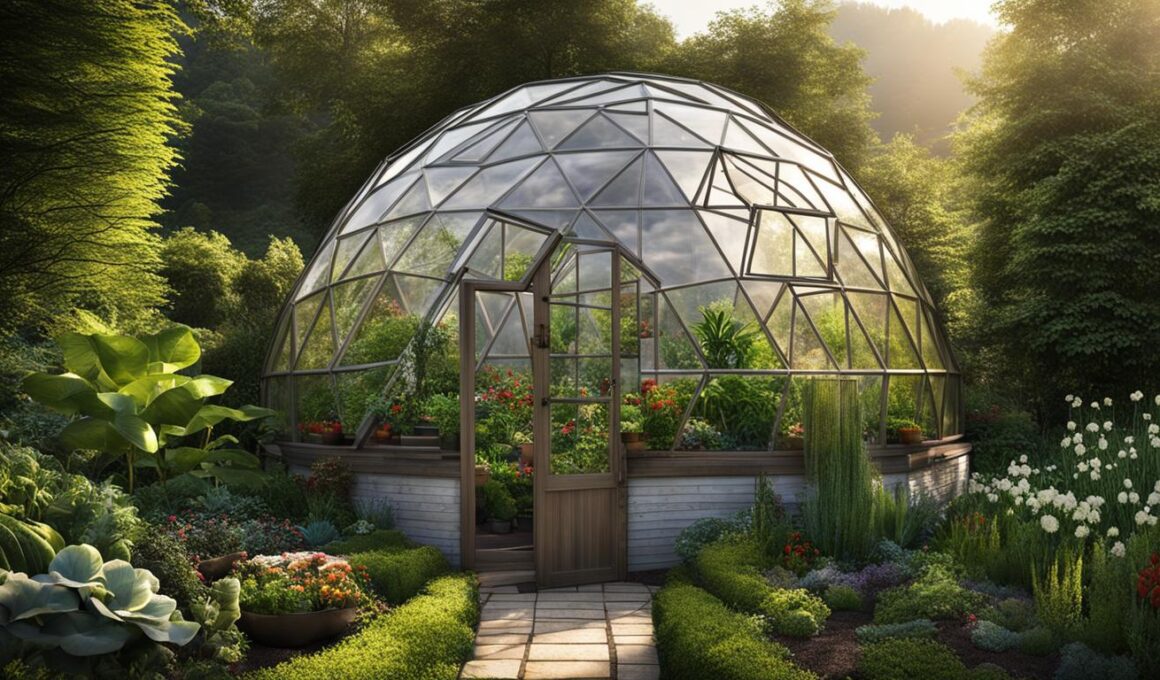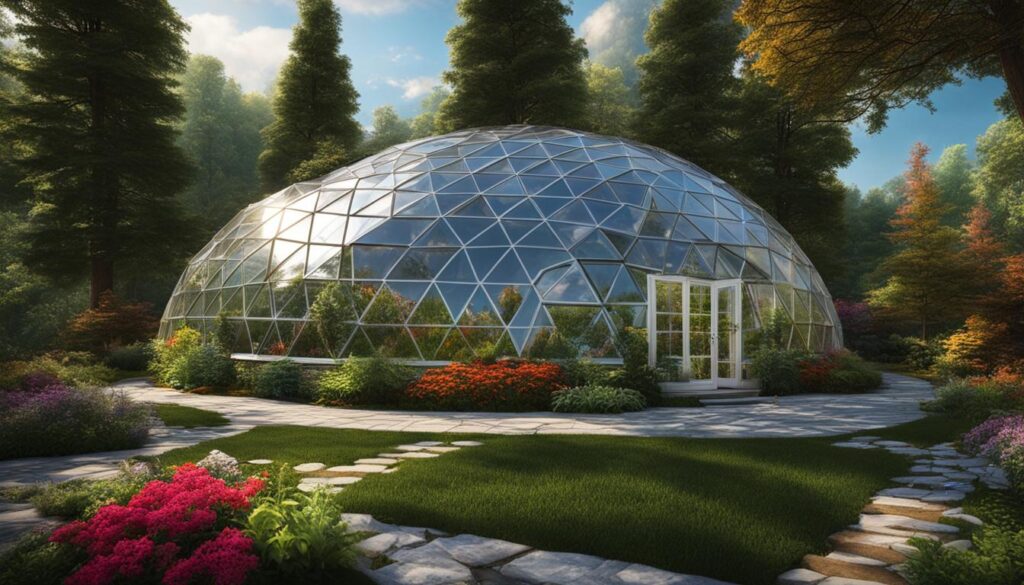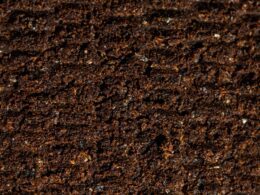As a gardening enthusiast, you may have come across the terms geodesic dome greenhouse and traditional greenhouse when exploring gardening structures. Both these options have their unique features, which can influence your decision to create a sustainable and year-round gardening space. The Growing Dome® represents a significant shift in greenhouse design compared to traditional greenhouses. It aims to provide an energy-efficient solution for backyard gardeners while offering year-round growing capabilities. Understanding the differences between these two structures can guide you in choosing the ideal gardening space that best meets your needs.
Key Takeaways
- Geodesic dome greenhouses offer a unique and futuristic design that enables optimal light penetration, insulation, and stable structural support.
- Traditional greenhouses may require additional heating or cooling systems to maintain optimal plant growth, while geodesic domes can efficiently regulate temperature using their passive solar design.
- Geodesic dome greenhouses are better suited for year-round gardening and can withstand extreme weather conditions compared to traditional glass-walled greenhouses.
- Both structures have their construction and maintenance challenges, but geodesic domes may require a more specialized skillset or professional assistance.
- Choosing between a geodesic dome greenhouse and a traditional greenhouse largely depends on your gardening goals, budget, and commitment to sustainable gardening practices.
Understanding Geodesic Domes and Traditional Greenhouses
As more individuals seek to start backyard gardening projects, choosing the right type of greenhouse becomes crucial. Geodesic dome greenhouses offer distinct advantages over traditional ones due to their stability, even weight distribution, insulation, and light utilization. Additionally, the geodesic design allows greenhouses to withstand extreme weather and provide longer growing seasons. However, attention must be paid to their complexity in setup, potential for higher initial costs, and increased effort for construction and maintenance compared to regular greenhouses.
Geodesic Dome Benefits:
- Greenhouse stability
- Even weight distribution
- Improved insulation
- Optimized light utilization
- Extreme weather resistance
- Longer growing seasons
Traditional Greenhouse Drawbacks:
- Less stable structure
- Inadequate insulation
- Uneven light distribution
- Lower resilience to extreme weather
- Shorter growing seasons
When considering energy-efficient grow solutions, it is essential to understand the fundamental differences between geodesic structures and traditional greenhouses. Table 1 highlights the key differences in both types of structures:
| Geodesic Domes | Traditional Greenhouses |
|---|---|
| Stable and even weight distribution | Structure may be less stable due to uneven weight distribution |
| Better insulation and energy efficiency | Lower insulation efficiency, leading to higher energy consumption |
| Optimized light utilization for plant growth | Less efficient light distribution, impacting plant growth |
| Resilient to extreme weather conditions | More vulnerable to extreme weather and damage |
| Extended growing seasons | Limited growing seasons and less conducive to year-round gardening |
Both geodesic domes and traditional greenhouses have their advantages and disadvantages. Understanding these differences can help you make an informed decision for your backyard gardening needs and choose the right type of greenhouse for your requirements.
The Unique Architecture of Geodesic Domes
Geodesic domes are gaining popularity as an alternative to traditional greenhouses, partly due to their unique architecture. The geodesic shape and solar greenhouse design facilitate even light and heat distribution, optimal sunlight use, and extreme weather resistance. Let’s explore the various architectural features that contribute to the geodesic dome’s strength and resilience.
The Geodesic Shape and Its Benefits for Light Penetration
One of the primary advantages of geodesic domes is their ability to provide even light and heat distribution throughout the day. While traditional greenhouses experience peak heat during midday and diminished light penetration in the morning and evening, geodesic domes maintain a consistent level of sunlight exposure. This is due to their solar greenhouse design and the absence of any elongated walls, which can cast shadows on plants during certain times of the day.
With a geodesic dome, plants receive continuous and evenly dispersed sunlight, leading to healthier growth and more productive yields. Moreover, it reduces the need for artificial lighting and heating systems, lowering energy costs and promoting sustainability.
Strength and Resilience Against Extreme Weather
Geodesic domes are known for their exceptional strength and resilience, making them highly suitable for regions prone to extreme weather conditions, such as heavy snowfalls, hurricanes, and powerful winds. The geodesic dome strength is attributed to the triangular geometric pattern, which lends itself to wind-friendly architecture and extreme weather resistance.
As opposed to traditional greenhouses, geodesic domes are designed to withstand substantial snow loads and high winds. The domes’ aerodynamic shape allows wind to flow around the structure instead of pushing against it, reducing impact forces and minimizing the risk of damage. As a result, these innovative structures are often considered hurricane-proof greenhouses.
| Features | Geodesic Dome | Traditional Greenhouse |
|---|---|---|
| Even Light and Heat Distribution | ✔ | ✖ |
| Solar Greenhouse Design | ✔ | ✖ |
| Optimal Sunlight Use | ✔ | ✖ |
| Extreme Weather Resistance | ✔ | ✖ |
| Hurricane-Proof | ✔ | ✖ |
| Wind-Friendly Architecture | ✔ | ✖ |
In conclusion, the unique architecture of geodesic domes offers significant benefits when it comes to light penetration, strength, and resilience against extreme weather. By choosing a geodesic greenhouse, you can ensure optimal growing conditions for your plants and reduce the need for artificial lighting and heating, ultimately promoting sustainable growing practices.
Comparing Insulation and Energy Efficiency
When it comes to maximizing a greenhouse’s potential, insulation and energy efficiency play a crucial role in providing a stable growing environment. In this section, we will compare the energy efficiency and insulation properties of geodesic dome greenhouses and traditional greenhouses, highlighting their differences and benefits.
- Passive solar design
- Greenhouse insulation
- Energy-efficient growing
- Sustainable greenhouse
Geodesic dome greenhouses are renowned for their passive solar design, which allows them to maintain consistent temperatures without relying on additional heating or cooling systems. The dome’s geometry enables the efficient capture of sunlight and the gradual release of heat throughout the day to prevent sudden temperature fluctuations. This balanced environment ensures optimal plant growth irrespective of the season.
On the other hand, traditional greenhouses often struggle to maintain a consistent temperature due to their simplistic design. This poses challenges, especially in temperature regulation during extremely hot and cold periods. Therefore, these structures often require additional support through heating and cooling systems to maintain a suitable growing environment.
Furthermore, the innovative design of geodesic dome greenhouses provides superior greenhouse insulation, which minimizes heat loss, particularly during cold winter nights. The triangular construction of the dome’s framework ensures even weight distribution and contributes to the structure’s overall strength and insulation.
Compared to traditional greenhouses, geodesic domes take the concept of energy-efficient growing to new heights. Dome greenhouses efficiently utilize sunlight and heat throughout the day, reducing dependence on electricity and external energy sources. This subsequently enhances the greenhouse’s sustainability and drastically lowers its environmental impact.
| Greenhouse Type | Insulation | Energy Efficiency | Sustainability |
|---|---|---|---|
| Geodesic Dome | Superior insulation due to geometric design | High energy efficiency with passive solar design and minimal heat loss | High sustainability due to reduced energy needs and limited environmental impact |
| Traditional Greenhouse | Average insulation, often requires additional support | Dependent on external energy sources for heating and cooling | Less sustainable owing to higher energy consumption and environmental impact |
In conclusion, geodesic dome greenhouses undoubtedly excel in providing a sustainable greenhouse solution through their passive solar design, enhanced insulation, and energy-efficient growing capabilities. While traditional greenhouses can still serve as viable options for seasonal growing, they require supplementary heating and cooling systems to create a stable growing environment, making them less energy-efficient and sustainable overall.
Year-Round Growing Capabilities
In a traditional greenhouse, achieving optimal conditions for year-round gardening may pose a considerable challenge. This is due to the limitations of their design which struggles to maintain a consistent temperature throughout the year. In contrast, geodesic dome greenhouses employ a passive solar design that effectively captures and retains heat, enabling gardeners to enjoy a sustainable and advantageous growing environment.
Passive Solar Design of Geodesic Domes for Heat Retention
The passive solar design of a geodesic dome greenhouse is crucial in its ability to provide year-round gardening. By effectively capturing solar energy during the day, the greenhouse warms its interior and maintains a consistent temperature. During the night, the retained heat is gradually released, keeping the interior at adequate temperatures for plant growth without requiring additional heating or cooling mechanisms.
Several components are critical in the heat retention process, including:
- Thermal mass materials: These materials help store heat and slowly release it when temperatures drop.
- Insulation: Proper insulation ensures that heat does not escape the greenhouse and that the interior maintains a stable temperature.
- Strategically placed vents: Vents are crucial in regulating the internal temperature by allowing hot air to escape when the greenhouse becomes too warm.
Limitations of Traditional Greenhouses in Season Extension
Traditional greenhouses are primarily used for extending the growing season but often face challenges in providing a year-round gardening solution. One of the significant drawbacks is their inability to maintain consistent temperatures without employing heating or cooling systems. This need for supplementary climate control leads to increased energy consumption and costs.
In addition to climate control struggles, traditional greenhouses may:
- Require additional shading material during warmer months, blocking light and inhibiting plant growth.
- Incur higher maintenance costs due to the use of heating and cooling systems.
- Be unsuitable for certain climates, limiting their effectiveness as a year-round gardening solution.
Geodesic dome greenhouses, with their superior heat retention, energy efficiency, and sustainable design, represent a practical and ecologically friendly choice for gardeners looking to overcome traditional greenhouse limitations and optimize their seasonal growing capabilities.
Construction and Maintenance: What You Need to Know
Building a geodesic greenhouse can be a time-consuming and labor-intensive task. Comparatively, constructing a traditional rectangular greenhouse is simpler and more straightforward. As you embark on your geodesic greenhouse construction, consider these crucial aspects to ensure a successful project:
- Plan and prepare a solid foundation for your greenhouse to ensure stability and longevity;
- Choose the right greenhouse materials, considering factors like insulation and durability;
- Follow the assembly instructions with utmost precision to maintain every aspect of the geodesic design;
- Be prepared for potential maintenance challenges and ongoing care that may require professional assistance or specialized skills.
The intricate design and complex geometric patterns of geodesic dome greenhouses necessitate a higher level of accuracy when assembling the structure. Moreover, the interconnected design requires special attention to correctly align the panels and secure the proper connections. While building greenhouses of this nature may be daunting, the long-term rewards may outweigh the initial effort.
Keeping your geodesic dome greenhouse in optimal condition involves more than basic maintenance tasks, such as cleaning and checking for pests. You may need to perform additional tasks to ensure the structure’s long-term durability and efficiency. These tasks may include:
- Regularly inspecting the structural framework for signs of wear, damage, or stress;
- Descending snow buildup on the exterior and checking the insulation routinely;
- Ensuring the automatic vents, windows, and climate control systems are functional and well-maintained;
- Addressing any issues promptly, as neglecting minor repairs may lead to more significant maintenance challenges in the future.
While the initial construction and ongoing maintenance of a geodesic greenhouse may seem daunting, the advantages they provide – such as year-round growing capabilities, energy efficiency, and unique architectural appeal – make them a rewarding investment for avid gardeners and eco-conscious individuals alike.
Pros and Cons of Geodesic Dome Greenhouses
Geodesic dome greenhouses have been gaining popularity among serious gardening enthusiasts due to their numerous advantages. However, they also pose some challenges that potential owners need to consider. Below, you’ll find a detailed analysis of the pros and cons of geodesic dome greenhouses.
Advantages of Stability and Growing Conditions
The greenhouse stability provided by geodesic domes is one of their most significant benefits. They offer excellent protection against harsh weather conditions and provide a safe growing environment for plants. Some advantages include:
- Resilient greenhouse design: Geodesic domes are built with even weight distribution, which contributes to their incredible stability during extreme weather conditions.
- Optimal growing conditions: The unique shape of geodesic domes evenly distributes sunlight and heat, providing an ideal environment for plants to thrive throughout the day.
- Extended growing seasons: Geodesic dome greenhouses allow plants to be grown year-round, significantly increasing the growing season compared to traditional greenhouses.
Challenges in Building and Upkeep
While geodesic dome greenhouses have numerous advantages, it’s essential to consider the challenges when constructing and maintaining these structures. Some potential challenges include:
- Geodesic dome construction difficulty: Building a geodesic dome greenhouse can be complex as it requires precise measurements and a solid foundation, which may necessitate professional assistance.
- Greenhouse maintenance: Due to the interconnected triangular design, maintenance and repairs can be more difficult compared to traditional rectangular greenhouses.
- Higher initial costs: The unique materials and specialized labor required for geodesic dome greenhouses may result in higher initial expenses.
| Pros | Cons |
|---|---|
| Superior greenhouse stability | Complex construction process |
| Optimal growing conditions | Challenging maintenance tasks |
| Year-round growing capabilities | Higher initial costs |
In summary, geodesic dome greenhouses offer several advantages, such as stability, optimal growing conditions, and extended growing seasons. However, the complexity of construction and maintenance should not be overlooked. By carefully considering the pros and cons, you can make an informed decision about whether a geodesic dome greenhouse is the right choice for your gardening needs.
Aesthetic Appeal and Environmental Impact
Not only are geodesic dome greenhouses functionally advantageous, but they also offer a futuristic and aesthetically pleasing design that can elevate the visual appeal of a property. With their innovative appearance, unique greenhouse structures such as geodesic domes hold the potential to increase property design value. These compelling features attract both novice and expert gardeners, as well as environmentally conscious homeowners who are interested in sustainable property enhancements.
The Futuristic Design of Geodesic Structures
The futuristic greenhouse design of geodesic domes stems from their intricate, interconnected triangular framework. This distinctive shape, inspired by the natural geometry found in substances like carbon and minerals, contributes to the geodesic dome aesthetics. Unlike traditional greenhouses with a more conventional appearance, geodesic domes create a striking visual statement that stands out among other structures.
Boosting Your Property’s Design Value
Geodesic dome greenhouses can significantly improve the visual and design value of a property. Apart from their eye-catching appearance, these greenhouses can help increase the property’s worth due to their notable sustainability features. Their energy-efficient approach to gardening aligns with environmentally conscious practices, appealing to property owners who are committed to reducing their environmental impact of greenhouses.
- Geodesic dome greenhouses demonstrate efficiency in utilizing resources and reducing energy costs. This feature is particularly attractive to homeowners looking to enhance their property’s green credentials.
- Due to their structural stability, longevity, and low maintenance requirements, geodesic dome greenhouses offer lasting functionality and value.
- The appeal of a year-round growing environment contributes to the investment rationale for adopting geodesic dome greenhouse structures.
In conclusion, geodesic dome greenhouses not only provide functional advantages but also offer a visually stunning addition to any property. Their futuristic design, environmental sustainability, and potential to boost property value make them an ideal choice for homeowners seeking unique and innovative greenhouse solutions.
Which Gardening Structure Provides Better Durability and Functionality?
When it comes to durability and functionality, the debate between plastic vs steel wheelbarrows is ongoing. While plastic wheelbarrows may be lightweight and rust-resistant, steel wheelbarrows are known for their sturdiness and ability to handle heavy loads. Ultimately, the choice depends on individual gardening needs and preferences.
Conclusion
Geodesic dome greenhouses offer a wealth of benefits that set them apart from traditional greenhouses, making them a top choice for gardeners seeking efficient, innovative gardening solutions. These unique structures present unparalleled structural stability, energy efficiency, and the potential for year-round growing, enabling you to maximize your growing season while embracing green living practices.
Despite some challenges in setup and maintenance, geodesic dome greenhouses ultimately provide a sustainable greenhouse solution. This innovative architectural approach not only ensures your plants’ optimal growth conditions, but it also adds an aesthetically pleasing and futuristic touch to your property.
Truly, geodesic dome greenhouses are worth considering for those interested in elevating their gardening endeavors, championing eco-friendly living, and exploring the cutting-edge world of sustainable greenhouse solutions.











